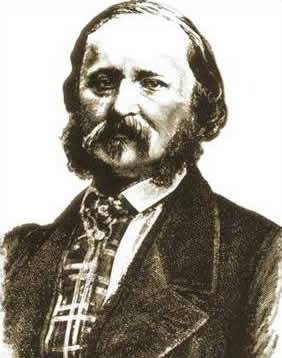Édouard Léon Scott de Martinville
History of sound recording started with the invention made by French printer and bookseller Édouard-Léon Scott de Martinville. Being fascinated with the human speech, and written language, he always dreamed about finding more scientific ways to explore this subject. For this purpose he created phonautograph, the earliest known sound recording device that proved to be instrumental into development of all future sound recording devices. Although his work was never intended for playing sounds, the basic design and function of phonautograph was direct inspiration for the Thomas Ada Edison's creation of phonograph, which represented true beginnings of the modern day gramophone.
Ever since his young age, Scott was fascinated with the human language, written or spoken. He especially focused on the transcribing spoken word into text, and for that purposes he spent a long time perfecting his ability of "shorthand" writing, introducing several notable additions to this form, which survives to today. Even though shorthand and its abbreviated symbolic form enabled the writer to record the human speech at much faster rate that with normal written methods, he wanted to further more explore the composition of human sound, from the moment it left our throats to the moment it entered our ears. For that purposes, he started studying human anatomy and finding a way to simulate speaking and hearing with mechanical aids. The result of his work was first sound recording device known to man - Phonautograph.

Created in 1857 after three years of work, phonautograph consisted of cone-shaped speaking horn with flexible moving diaphragm connected to his smaller end. This cone gathered the sounds from its vicinity, transferred changing air pressure to the diaphragm which moved the styles that was attaché to it. Recording of data was done by connecting moving part of the stylus to the piece of moving paper (located on a moving drum) which was coated in thin layer of black soot. Data that was made in this way gave Scott insight into look of human speech that was unavailable until that time, and his discovery enabled many scientist of that time to further more test the properties of sound.
Scott de Martinville never intended to produce machine that would playback the recorded sound data, and during his life he patented Phonautograph and offered it to several scientists and universities. Even though he never managed to make money of this device, he created a big impact in the scientific community for decades to come. 17 years after the first showcasing of phonautograph American inventor Thomas Ava Edison improved upon Scott designs and created a first recording and playing device phonograph, which started an era of personal sound devices that is present all up to today.
Recordings that Scott made over 160 years ago represent important legacy of human history and the evidence of our ingenuity in face of great problems. Several paper sheets with phonautograph recordings were recently found, and converted to sound using digital processing. Recording of Scott singing famous French folk song "Au Clair de la Lune" on 9 April 1860 represent the oldest surviving recording of human voice at current time.
